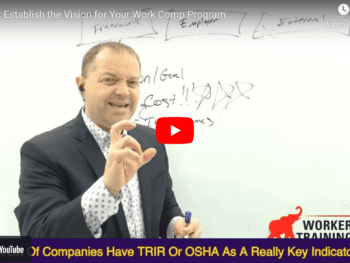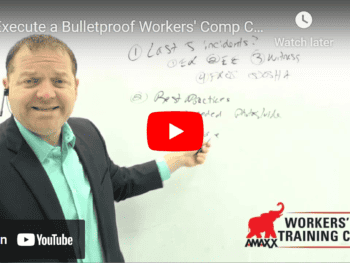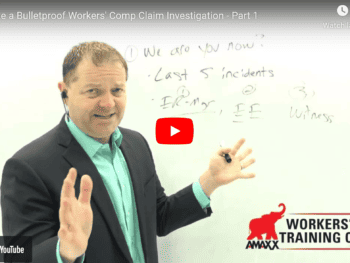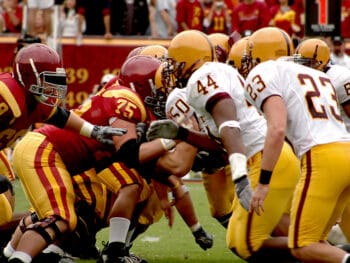This post is one in a 3-part series:
You can either win a workers’ compensation litigation case at the end, or you can win it at the beginning. Hello, my name is Michael Stack. I’m CEO of Amaxx, and this is part two of our series in regards to executing a Bulletproof workers’ comp claim investigation. The concept here of what we’re trying to do and what I talked about in video number one is putting in a consistent system in place so that you can regularly, consistently expect a thorough documentation of your workers’ compensation claims. And when you do that well, when you do it consistently well, when you’re documenting these incidents consistently, well at the beginning when people know what happened, people remember what happened, people have the capacity to document what happened. You’re going to set yourself up for success to win workers’ compensation cases at the beginning, before they ever get to the courtroom.
Step 1: Review Last 5 Incidents
And that, by the way, is significantly, significantly less expensive, creates a significantly better outcome for that injured worker and just creates a much, much easier and much better run system in regards to your work comp program. So step number one, what I talked about in that first video, just as a reminder, is I talked about evaluating your last five. So your last five incidents evaluate how you did. Do you have a injured worker report of injury? Do you have a manager report of injury? Do you have a witness report of injury? How well were your last five state first report of injuries filled out? How well were your last five OSHA 3 0 1 reports filled out? So how did you do on those last five? Video Number one was all about just documenting where you currently are in your program. If you don’t know where you are, how can you improve?
Click Link to Access Free PDF Download
“The 5Cs to Taking a Bulletproof Injured Worker Recorded Statement”
So just baseline it. Where are we now? What is our baseline in terms of our last five incidents? How are those looking for us? Okay. Now as we move into point number two here, this point number two, this step number two, this video number two is really all about saying, okay, now that you know where you are as your baseline, let’s start to work to improve. Now let’s work to improve. What are some action steps that you can take? What are some of the best practices you want to consistently implement to get that thorough accident investigation out of the gates consistently done? Well, here’s a few things that we are looking for. We’re looking for open-ended questions, open-ended questions.
Step 2: Document With “See Attached” Philosophy
There’s the attorney friend that we know I’ve worked with for a long time says The best way to document an injury, particularly on those state forms, and this is just more of a philosophy, is regards to say something like, see attached. See attached. If you have this philosophy of see attached, that means we had more information on here for the form than we were able to put into it. A lot of those state forms in particular, it’s like, what happened? Alright, well there’s this much space for you to fill out what happened. You want to be able to have this philosophy, this general philosophy of see attached. So do you have open-ended questions or do you just have check boxes on your forms? Do you have open-ended questions or do you just have check boxes on your forms? Second piece here is your accuracy of your accurate.
Let’s just put accurate data, the accuracy of your data. So often when we go to court, when we go to the courtrooms or an attorney is working through this and talk to any defense attorney and they’ll back me up on this statement, a lot of times this information, the essential information is just wrong. What is the date of the injury? What is the date of the injury? What was the actual injury date? What was the employee name that actually got injured? Who was the employee? What was the date of injury? And what was the location that they actually got injured at? Some of this fundamental information? What was their social security number as well, that goes on the state first, support of injury. That goes back to the accuracy of the data. Obviously there’s some data security stuff to look through there. Who has access to that state First support of injury?
Put System In Place to Manage Data Consistently Well
Who has access to this data? Putting a system in place for you to be able to manage this and do this consistently well? So what was the date of injury? What was the employee’s name? What was the location? What was their social security number? What is their average weekly wage? What is their average weekly wage? And obviously adjusters can get involved with this in regards to the collection of this data, but the more that an employer has a system to document consistently, who’s in charge of this? Who’s in charge of this information? When somebody gets hurt in this particular location, this is the person that’s in charge and we need to notify them so that we can collect this information and we can get it to the adjuster so that they can do their job well, by the way, if you haven’t heard adjusters have a lot to do. They got a lot on their plate. They got a lot of caseloads in regards to information that they have to manage on a regular basis. The accuracy of the data open-ended questions, accuracy of data. And the last piece that I want to give you here is photos and video. Photos and video videos and photos.
We’ve talked through a lot about the defense attorney presentation of court. When we talk about what is the best quality evidence in a courtroom, it’s here. It’s here. It’s photos and videos. It’s photos and videos. The best highest quality evidence, far superior to an eyewitness, far superior to an eyewitness because an eye witness’s testimony and memory can change. It can be altered over time. Photos and videos don’t change. They don’t alter. If you can get photos and videos of the accident scene consistently done well now your accident investigation in terms of what happened in terms of being able to make a good decision with good information has done significantly, significantly better. We want open-ended questions on your forms. We want accuracy of data. We want photos and videos of each incident consistently. And by the way, with this, you should have a system. A lot of these questions on these incident forms.
Accurate Data
I talked about the manager, I talked about the employee, I talked about the witness. A lot of these questions on these forms. Do you think there’s a lot of duplicate entry in regards to these forms and these state first supportive injuries? Or did I have this in regard to the state first supportive injury in osha? Are they asking the same stuff? Do they need to know the same stuff? So obviously it’d be great to have a way to be able to take the information that you put in here and flow it through here just to save some data entry. Because last time I checked, people hate data entry. It takes a lot of time and it’s very inefficient to get this accuracy of data in terms of your system, in terms of a way to document what is going on at your organization. We won’t open-ended questions.
We want accurate data. We want photos and video consistently done well. Step number one, we took a look at your last five incidents. Now you’re taking a look at how do we improve? Okay, maybe, well, we don’t have photos and videos actually on any of ours, or maybe one or two of ’em, but it’d be great to have ’em on all of them. We are not actually open-end questions or maybe our forms are pretty good. We’ve got decent forms here. We’re asking some pretty good questions here. But our accuracy of our data, when I looked at this, it was pretty poor. There’s some room for improvement there. Okay, now who do we need to identify that’s in charge of these things that we need to train up on? How to do this consistently? So it’s all about just identifying where are you starting, where do you want to go?
Who Do You Need to Train?
Who do we need to train in order to improve in that area? And then you create that action plan to move forward. So that’s video number two. Video number one, it was all about documenting where you are in terms of your baseline. This video is all about saying, okay, what are these best practices? And now how do we identify the person responsible that we need to train on how to do this and do this consistently? Well? Implementing a system to document injury as well at the time of injury is going to lead to massive results. Remember, your work today work’s. Compensation have a dramatic impact on your company’s bottom line, but it will have a dramatic impact on someone’s life. So it’d be great.

Contact: mstack@reduceyourworkerscomp.com.
Workers’ Comp Roundup Blog: http://blog.reduceyourworkerscomp.com/
©2024 Amaxx LLC. All rights reserved under International Copyright Law.
Do not use this information without independent verification. All state laws vary. You should consult with your insurance broker, attorney, or qualified professional.














